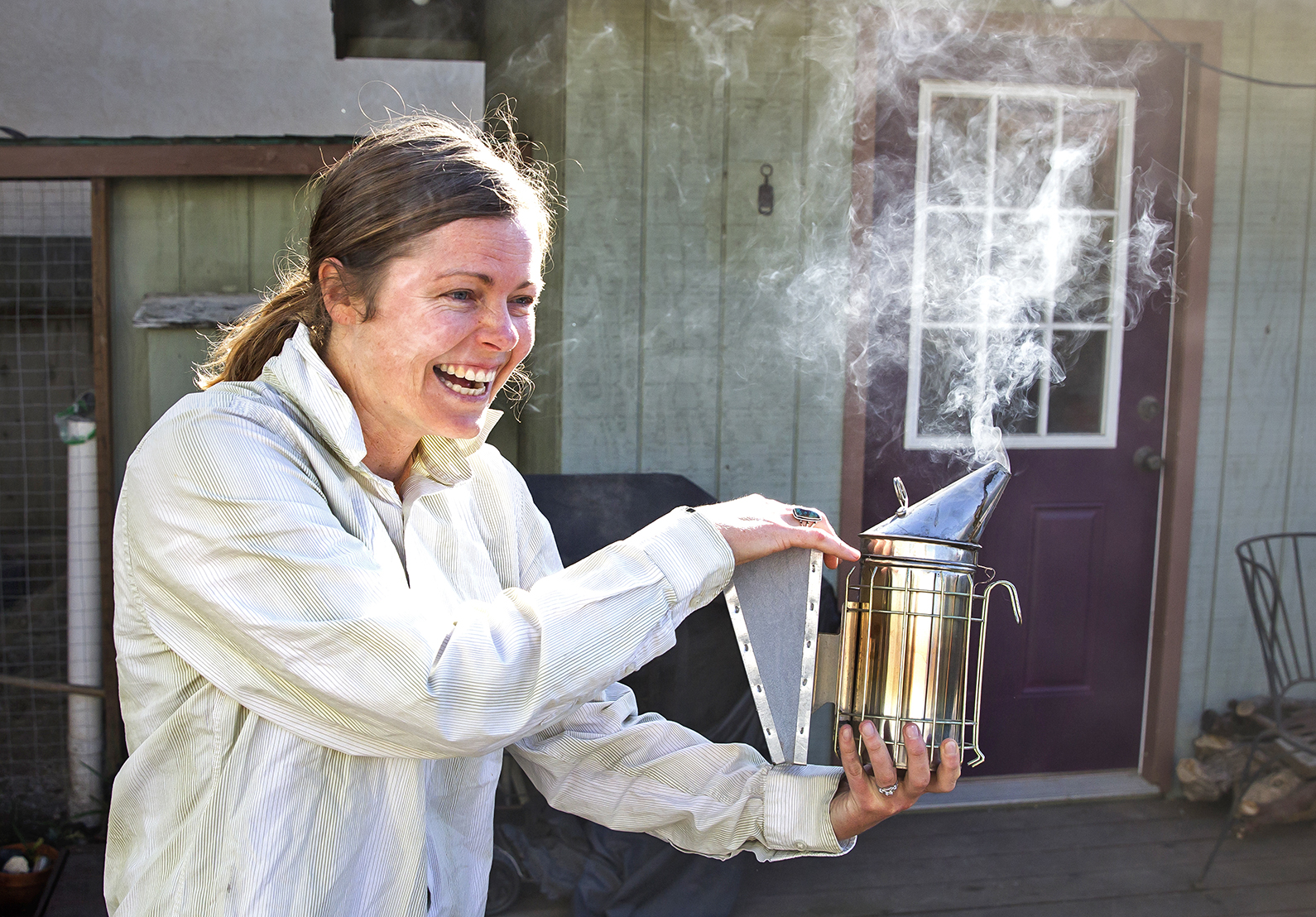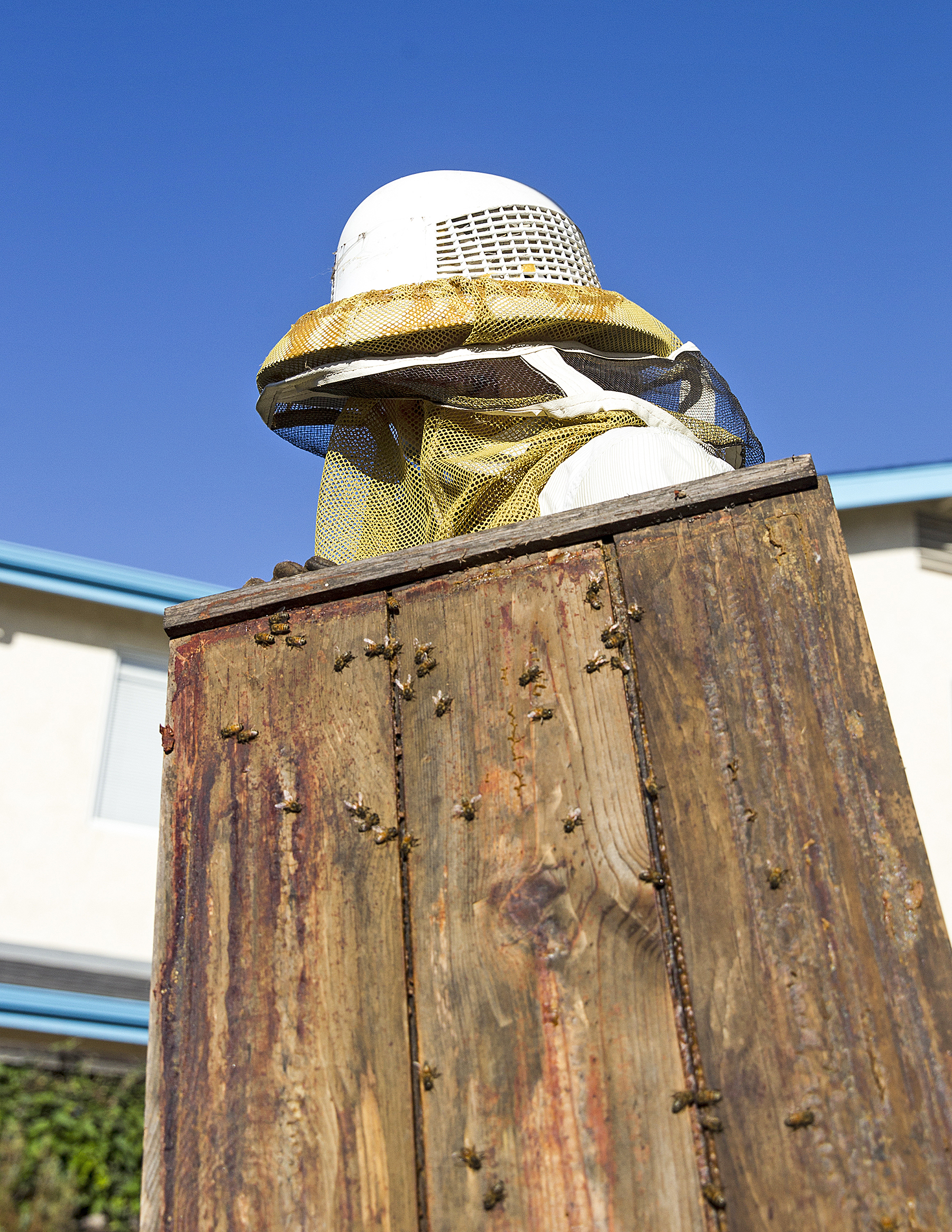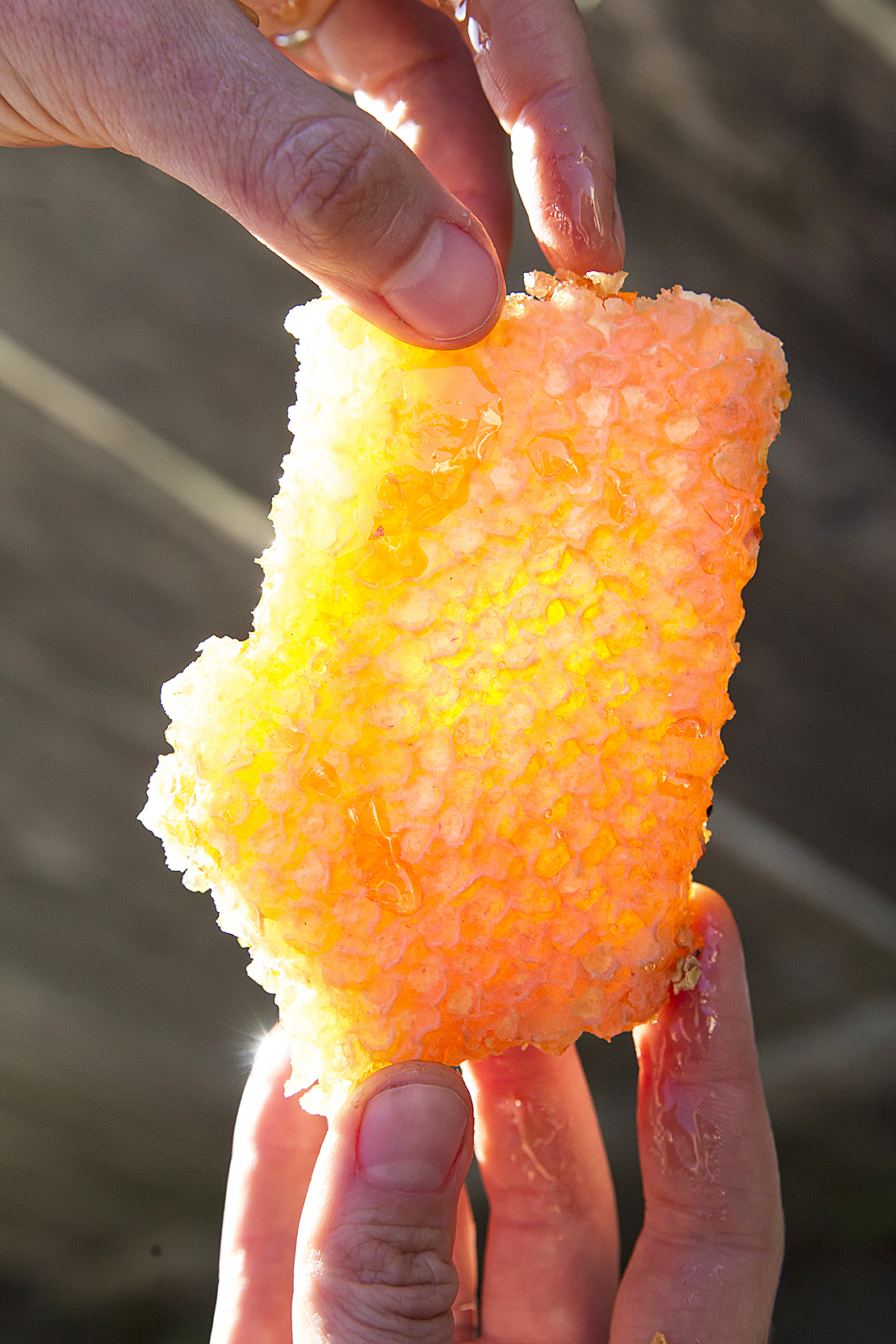Life, Death, and Honey: On the Swarm Hunt
THE WAGGLE DANCE
Wild bees are busy for a reason. They’re trying to survive. Look closely, and you might even see one performing a strange figure-eight dance that communicates everything from the location of flowers yielding nectar and pollen to water sources to possible new homes.
I’ve stepped out of reality and into a full-body beekeeper’s outfit. It might as well be a spacesuit. Instead of holding a tiny American flag in the middle of space, I’m clutching a pole hooked around a tree branch suspended 4 feet above my head.
Hovering on that branch? A massive swarm of boisterous, buzzing wild bees.
A few feet away lies the husk of their old home, a hunk of tree that suddenly and inexplicably shattered to the ground. Over the past two days, everything has gone to hell for this colony, which encompasses thousands of displaced insects.
Ants have devastated their fallen hive, a twisting, freeform masterpiece of honeycomb hidden beneath resinous bark. Ants have also eaten their nectar, honey, and royal jelly. Larva—even the capped brood (pupating bees nearly ready to emerge from their nursery cells)—have been left for dead.
Needless to say, this swarm is not stoked.
Sweat drips down my neck as Sue Hulsman, dressed in her own protective space suit, gives me the pulse-quickening signal. Her business, The Queen Team, eats jobs like this for breakfast.
“Bump the branch,” she says, her face obscured by fine mesh netting. It’s about 11 a.m. on a hot, Paso Robles morning a few blocks from Flamson Middle School. No one’s watching this personal moon landing, my first foray into the thrill of the swarm chase.
One small leap for me ...
I give my pole a good yank and hold my breath.
Nothing. The bees only vibrate in annoyance, keeping their teardrop shape intact, a seemingly solid mass of black, brown, gold, and yellow.
“Harder,” Hulsman says, with palpable anticipation. I give another tug.
One giant leap for New Times ...
What happens next is otherworldly, psychedelic. Time slows down. The swarm disperses like a slow motion bomb, thousands of bees shaken from a fitful nap. I can feel the electric insects buzzing, dancing all around my body.
Nothing could have prepared me for this moment. Chasing a swarm is like witnessing the cresting of a tsunami or standing in the eye of a tornado. It’s surreal. And a little scary. And totally addicting.
Meet the bee wrangler
“This is like a really good rock concert,” I finally muster, totally in awe of the buzzing cloud all around us.
“No, it’s like a rodeo,” Hulsman responds with a fearless cackle.
She’s right.
The swarm we’ve coaxed from this tree may have taken flight, but—like a flock of birds or school of fish—they have a collective mind all their own. They could easily “swarm off” never to be seen again, but Hulsman is here to wrangle them in.
“Can you smell banana peel? That’s their pheromone scent,” she says, holding up a plastic tub now blanketed in bees. She points to a single specimen, waving its butt in the air, wings whirring. “They have a gland under their tail. They will all sit here and fan and say, ‘Hey the queen is here.’ Now we know we got ’em. We can march them right into the hive.”
Hulsman coaxes the bees from the plastic container to a wooden-top bar hive on four legs, a deluxe bee FEMA trailer, if you will. They are thrilled by the scent of a small mason jar full of natural sugary goodness (Hulsman will have to grease the legs of the hive later to deter those insatiable bees from pillaging this home, too). Although we can’t see the queen with her large, commanding body, we know she’s in there. The beekeeper is picky about queens. Good queens mean healthier colonies and, as a result, a healthier planet.



Why is this so important?
Approximately one in three bites of the food we eat every day relies on honeybee pollination. A loss of biodiversity (the dying off of bee populations) can have serious implications throughout the agricultural ecosystem: Flowering plants co-evolved with bees; they are inextricably linked. Without honeybees, the global food supply is impacted due to the extensive role that honeybees play in North American agriculture, one of the largest food-exporting regions in the world.
Hulsman will let this new colony build up its reserves with one cycle of new brood (from larva to pupa to adult) before assessing the queen. She may need to “re-queen” the group with a better leader.
After all, there’s a lot hanging in the balance.
We crouch down in the grass and inspect our catch for the day. The bees start to relax as they feed from the sugar and make their way into the new sanctuary. Hulsman harvests a few chunks of comb from the fallen tree branch, containing capped brood uneaten by ants. The wet brood—exposed young larva—have long since been devoured. She’ll take the salvaged cells home, vacuum off any ants, then reintroduce them to the new hive.
“This is extremely valuable to the colony,” she says, holding up the comb to the light. “Try to count how many square inches of capped brood cells there are; you can’t. Each one will grow up to be an adult bee in just a matter of days.”
One small chunk of comb can represent thousands of bees. What she holds in her hands is a tiny universe that—if destroyed—affects us all.
No bees, no bounty
In a way, the bees owe a debt to thrill-seeking swarm chasers. This surviving colony, no longer homeless, can now return to its important job of keeping the world turning. Hulsman says that, overall, this newly captured group looks hardy and genetically diverse.
“I look at the color of the drones not just the workers. These are triple-striped Italian. The drones are really dark; that means they are a little Carniolan,” she says.
Only seven species of honeybee produce all the world’s honey, so the strength of this group signals good news, considering the sorry state of bee health today. The beekeeper says it’s “amazing that they even survived in the tree branch over winter.”
Winter—even our mild Central Coast winters—are hard on the bees, who become even more vulnerable to starvation, failing queens, wet hives, disease, and bad stock selection (picking the right variety of bee is a lot like choosing the right cattle genetics, or the right native plants that will thrive in your particular microclimate).
When you consider the fact that 70 percent of all plants on earth need pollinators to survive, these small decisions add up to big results.
According to data generated by the USDA, overwintering losses—the overall indicator for bee health—for managed honeybees from 2007 to 2011 ranged from approximately 28 to 33 percent compared to a historical rate of 10 to 15 percent. More and more, bees are succumbing to lack of forage, disease, and incidental pesticide exposure.
As you are probably aware, Colony Collapse Disorder (CCD) has been making headlines for about a decade. Here’s how it works: The workers suddenly vanish, leaving behind a queen, some food, and a few nurse bees to care for the remaining immature bees and the queen. The colony cannot sustain itself and dies out, much to the devastation of hobbyists and commercial beekeepers alike.
According to the U.S. Environmental Protection Agency, CCD remains a big issue, even if numbers have dropped from 60 percent losses in 2008 to 31.1 percent in 2013.
In about 10 minutes, most of Hulsman’s swarm has been successfully relocated to the new hive, but their journey has just begun. They’re headed to her rural vineyard property in Kiler Canyon—and from there, the packages (contained colonies) will be given to other like-minded beekeepers.
This is just a normal day’s work for Hulsman, who takes swarm calls several times a week. But she doesn’t always get that call. I ask what happens when someone reports a bee swarm to a commercial pest removal service.
“They put a bag around them and spray poison,” she says.
As it turns out, bees have yet another enemy to contend with: human ignorance.
To spray or not to spray?
Long gone are the days when Martha and Curt Van Inwegen would eagerly taste new batches of their spiced Therabee Culinary Honey emulsifying in the sun.
The death of their Atascadero-based honey operation—a collection of several hundred hives—took hold slowly over the past few years. Now, the couple is focusing on their sister company Life Elements, which produces natural skincare products.
I reached Martha by phone, asking her what it was like to witness the unimaginable. Her bees foraged on a remote airstrip surrounded by 500 acres of wilderness (bees are known to travel as far as 2 miles to search for food).
“In the span of seven months, we went from 15 hives at that location to one,” she says, adding that pesticides were likely the culprit. Martha described the ghoulish scene: Hundreds of dead bees lying motionless on the ground in front of the hive.
“You can literally scoop the bees up with your hand,” she adds. “They fly back with pesticides, which slowly kill them. They can’t get back into the hive because other other bees can smell it. The guard bees prevent them from coming in.”
The California drought compounded troubles for many local beekeepers in recent years, making available forage for bees even scarcer. In Martha’s case, warring bee tribes actually took over a few of her hives, forcing out her colony so that they could plunder the nectar within.
“Its almost like Armageddon; its like a war between the bees inside the hive and those robbing,” she says. “The hive moves out looking for a new food source. It’s one constant battle after another; either it’s the pesticide company or Mother Nature.”
Buzzing on heaven’s door
If you hold up a jar of Rock Front Ranch honey, you’ll see a sticker on the front that reads, “Tested: No Glyphosate.” Not sure what that is? Try its street name: “Roundup.” Everyone from commercial farmers to homeowners knows that this ubiquitous pesticide kills weeds rather effectively. What they may not know? It kills bees effectively, too.
“Just listen,” says jujube farmer Alisha Taff, owner of Rock Front Ranch, located in rural Santa Maria. This is a polite way of saying, “If you really want to understand the bees, you’ve got to stop talking and start tuning in to their world.”
Located off Highway 166 East, far from any cell service, this land sits in the gateway of the Cuyama Valley, where wild and kept bees gorge themselves on miles of chaparral and oak forests. Surrounded on all sides by the Los Padres National Forest, natural streams (once dry from the drought) provide fresh water.
Taff’s honey is raw, natural, and sought after. In fact, on my way out to the ranch, I notice miles of white bee boxes speckled across neighboring properties, too. Head farther east and you’ll find fruit trees and wine grapes, which all need pollinators.
Here, there are no fields that need pollinating (save for Taff’s jujube operation). Instead, commercial beekeepers truck hives to the land to create a singular crop: prized California wild sage honey.
Taff gives me a taste of her sweet sage honey while chickens strut across rocky terrain. She’s been making raw sage and wildflower honey since 2013, and you can find jars at SLO Natural Foods Co-Op and through SLO Veg’s CSA program.
“Sage honey from our native chaparral sages are the most exclusive prized type of honeys. The flavor, the single source varietal, comes from one source of pollen nectar and it does not crystalize,” she says. “Lots of beekeepers value honey produced in this area, but Mother Nature dictates whether or not we’re going to have honey.”
Thanks to precious rain, Taff had a good sage honey harvest last year, but some folks east of her were not so lucky. As you can guess, this pristine land—about 40 miles from the ocean—is in high demand. She, like many ranchers around here, will allow commercial beekeepers to use land for foraging, although not all are as adamant about producing a natural, sustainable product.
“If you have the available forage for the bees, people will contact you about keeping bees on your land,” she says, adding that these partnerships are largely invisible, save for bee boxes you might spot from your car window.
These pockets of “bee heaven” do still exist, although they are becoming scarcer and scarcer.
Truckers of the bee world
When I catch Jack Rudolph of Stepladder Ranch, he’s in Fresno, taking his heritage breed pigs to slaughter. Before you feel too bad, these pigs live on a beautiful mountainous farm in Cambria, where they can nosh on leftover avocado meat and dairy byproducts from the farm’s goat cheese operation. Rudolph pays a commercial pollination company to come to truck thousands of bees to his farm each spring.
You may know that Central Valley almond trees notoriously need about two hives’ worth of bees to pollenate just 1 acre, but did you know that Central Coast avocados are just as demanding?
“We grow 40 acres of avocados, and they bring us 100 hives; it’s about two or three per acre,” Rudolph says. “We do have native bees and wild hives, but for us, at the very least, it’s an insurance policy. When you have 5,000 avocado trees blooming, you better believe I’m bringing more bees in to cover our ass.”
Stepladder then buys discounted honey back from the beekeepers, who process and bottle on site. Each glass bottle of Avocado-Sage Stepladder Honey, (found at Fromagerie Sophie in downtown SLO as well as the Cambria, Templeton, and Los Osos farmers’ markets), helps offset the cost of avocado pollination. This honey is offbeat: uniquely spicy and smoky—made possible by six million bees.
“Sometimes we have problems with black bears trying to eat the honey,” Rudlolph says. “They will tip the hives over and wreak havoc. There’s no other animal that’s willing to take 1,000 beestings for that honey.”
No bee left behind
Back at the swarm chase, Hulsman contends with a smaller, more toxic predator. Varroa mites—ticks that feed off young bee larva—majorly compromise colony hygiene and immunity. She begrudgingly sacrifices a few capped broods from their cells and peers into the face of wriggling bee larva. No mites for now, but that doesn’t mean every bee is safe.
This is exactly why Hulsman and her friends at the Central Coast Beekeepers Alliance believe in spreading education first and foremost.
Before the day is out, pictures and video of the new hive will be uploaded to the Central Coast Beekeeper’s Facebook Group. Here, clicks and comments translate into real hope for these bees.
Lindsey Morgan is one such crusader, a teacher at heart. As program director for the SLO Botanical Garden, she understands that bee education starts with one person making a change. Maybe that’s why the bees “found her.”
“About a year and a half ago, I found a beehive in a dumpster. It still had some frames in it, so I took it home,” she says during an interview in her Morro Bay backyard. “Two months later, the bees arrived on their own.”
Here, poppies tower as tall as our shoulders and the scent of the sea is on the breeze. Morgan lights up a smoker to calm the bees, throws on a long sleeve shirt and a used beekeeper hood. She removes a frame, honey dripping down onto her gloves. “Don’t worry,” she says, “They reuse everything: the honey, the wax, the propolis.”
Beloved by ancient Egyptians, propolis is a resinous material that bees use to seal small cracks in the hive (beeswax seals the larger gaps). Bees make it by mixing honey with resin from trees and plants.
Both Morgan and Hulsman make their own propolis oils, which—like raw honey—feature antimicrobial, anti-fungal, and anti-viral benefits great for healing burns and crushing cold and flu viruses. A pinch of pollen can do wonders for allergies.
Morgan doesn’t get much honey for her labors—maybe two or three harvests from her small hive—and she uses the bounty for gifts, home beer brewing, and salves.
“Might as well. The chickens eat my garbage; the bees pollinate and don’t hurt anyone. It’s a nice perk,” she says. “I’ll take out two frames, save the good-looking honeycomb for gifts, then put the rest in a double boiler, allow the wax to rise to top then skim it. DIY living is making a comeback and, unless you’re allergic, beekeeping really isn’t that hard or dangerous.”
As a homeowner, Morgan didn’t worry about setting up the hive, but she says non-homeowners do need to brandish a sign (note: each city has its own specific beekeeping regulations, which you can find at slocounty.ca.gov). One thing to know: All owners of apiaries—be they home to a single insect or a thousand—must register with the SLO County Ag Commissioner, who can then alert beekeepers of pesticide applications in their specific areas.
Here, near the coast, Morgan has the benefit of knowing that her bees eat freely and healthfully.
The proof? It’s in the pudding, so to speak.
“If you compare this to store-bought honey, it’s very red,” she says, sharing a glob with me. “That’s the bottlebrush plants, giving it that robust color.”
Future beekeepers in progress
At Hulsman’s house, the whole family “speaks bee.” Hulsman’s dad constructed custom bee hives for years, her mom still helps tend the insects, and her husband and three kids do everything from capturing wild swarms to collecting the delicious, golden reward.
The chase is over, and Hulsman encourages me to suck the cream colored royal jelly from a discarded cell, thereby initiating me into the beekeeper’s code—or at least, that’s what I imagine.
In a world where bees are not always welcome, it is this person-to-person education—that bee-to-human bond—that allows us to make a change for the better. It might start with planting more bee-attracting flowers, switching to natural gardening methods, or starting your own apiary.
Or—as it did with me—it might start with the trill of the chase and a jolt of adrenaline.
“After chasing some really big swarms with me last year, my 10-year-old son made me sign a paper that says if I get a swarm that I know is more than 6 pounds, please take him out of school,” Hulsman says with a laugh. “He wants to chase the big one.”
Honey, we got you
Got a swarm that needs saving? Go to suziandthequeenteam.com. Want to learn how you can get involved in beekeeping and/or saving the bees in your own community? Contact the Central Coast Beekeeper’s Association on Facebook. The group meets monthly at the Oak Creek Commons, 635 Nicklaus Drive in Paso Robles.





